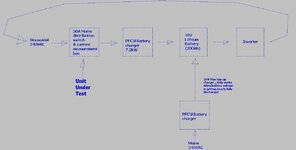cupoftea
Advanced Member level 5
Hi,
[sorry for new post....this is an entirely new approach to previous posts]
The attached is a test set-up for load test of a Mains distribution box (it contains a relay and some current measurement CTs). Its for 240VAC mains. It passes 30A.
We need to fully load it in order to test it.
As such, we wish to load it with a battery charger and battery as shown.
Do you think the inverter should be a grid tied inverter, or will it just be much cheaper to just use a non grid tied inverter as shown?
(As shown in the attached, the Grid mains does actually get used in order to make good the losses from the battery charger etc...otherwise the battery would go to full depletion, as you know)
[sorry for new post....this is an entirely new approach to previous posts]
The attached is a test set-up for load test of a Mains distribution box (it contains a relay and some current measurement CTs). Its for 240VAC mains. It passes 30A.
We need to fully load it in order to test it.
As such, we wish to load it with a battery charger and battery as shown.
Do you think the inverter should be a grid tied inverter, or will it just be much cheaper to just use a non grid tied inverter as shown?
(As shown in the attached, the Grid mains does actually get used in order to make good the losses from the battery charger etc...otherwise the battery would go to full depletion, as you know)
Attachments
Last edited:
